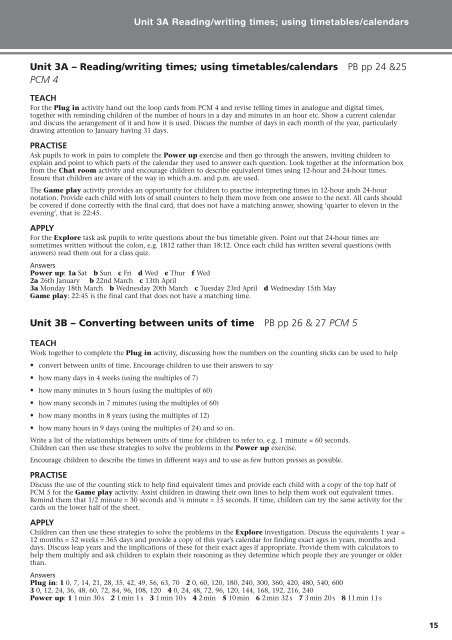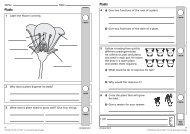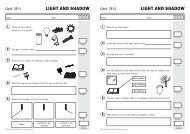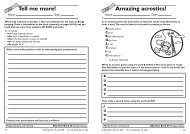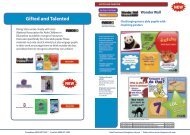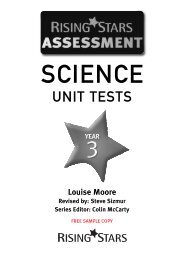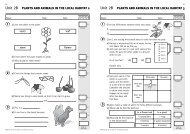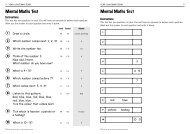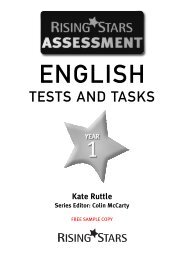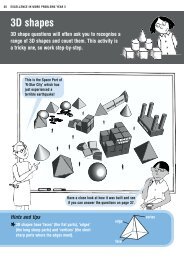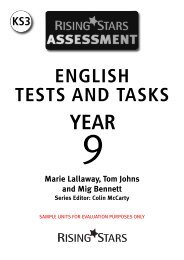Unit 3A â Reading/writing times; using timetables ... - Rising Stars
Unit 3A â Reading/writing times; using timetables ... - Rising Stars
Unit 3A â Reading/writing times; using timetables ... - Rising Stars
You also want an ePaper? Increase the reach of your titles
YUMPU automatically turns print PDFs into web optimized ePapers that Google loves.
<strong>Unit</strong> 3D Calculation and money problems<strong>Unit</strong> 3C – Adding <strong>times</strong> and finding time differences PB pp 28 & 29 PCM 5TEACHBegin by orally counting on <strong>using</strong> <strong>times</strong>, such as:• in 5s from 2:45 • in 10s from 6:20• in 10s from 11:25 • in 20s from 4:40• in 15s from 8:30• in 30s from 9:17 etc.Use a clock-face to support the activity where necessary.Then ask the children to complete the Plug in activity and discuss the answers together.Write the <strong>times</strong> 5:35 and 6:20 and ask children to read the <strong>times</strong>, describing them in different ways, e.g. five thirty-five ortwenty-five to six, and to show you them on a geared analogue clock. Explain that the lesson will focus on findingdifferences between pairs of <strong>times</strong>. Allow them to count around on the clock-face to find the difference between 5:35 and6:20 (45 minutes). Draw two lines similar to those in the Chat room activity to show two ways of finding the differencewithout a clock-face to look at. Encourage discussion and help children to talk about the lines in the Chat room activity.PRACTISEChildren can then use these strategies to solve the problems in the Power up exercise.As children move on to the harder problems, help them to realise that the number lines can include hours and then days.Answers can be given in different ways, e.g. 26 hours or 1 day and 2 hours etc.For further reinforcement, provide each pair with a copy of PCM 5 and a geared analogue clock for the Game play activity.The children should only use the cards from the lower part of the sheet.APPLYChildren can then use these strategies to solve the problems in the Explore investigation. Here <strong>times</strong> are given in 24-hournotation. Again encourage children to draw time lines to help solve each problem.AnswersPlug in: a 3:47, 3:52, 3:57, 4:02, 4:07, 4:12 b 7:23, 7:43, 8:03, 8:23, 8:43, 9:03 c 12:55, 1:10, 1:25, 1:40, 1:55Power up: 1a 30 mins b 42 mins c 2 hrs and 31 mins d 3 hrs and 35 mins e 40 mins2 7 hrs and 58 mins3 4 hrs and 1 min, 24 hrs, 17 hrs and 30 mins, 25 hrs and 30 minsExplore: a 2 hrs and 30 mins b 1 hr and 55 mins c 1 hr and 35 mins d 3 hrs and 25 mins e 1 hr and 45 minsf 2 hrs and 15 mins<strong>Unit</strong> 3D – Calculation and money problems PB pp 30 & 31TEACHThe Plug in activity can be used to encourage quick mental calculation of amounts of money. Show how amounts can berounded to a whole pound and then adjusted to find the exact answer, e.g. £5.99 × 4 = £6 × 4 – £0.04 = £23.96. Remindpupils that when <strong>writing</strong> money in pounds/pence notation they should not use the letter p, e.g. £3.05, not £3.05p. Discussalso the importance of not mixing up pounds and pence, e.g. when adding £4 and 50p not getting the answer £54 bymistake!PRACTISEPupils can then practice dealing with prices in pounds and pence by solving the problems in the Power up exercise.Encourage them to write number sentences to show how they worked out each problem. Discuss the answers together.Working with a partner they should talk about how to solve the questions in the Chat room activity. Ensure that theyrealise that they should divide to find the price of one and multiply to find the price of many. For further reinforcement,ask them to try the Game play activity. Each pair will require a set of counters and paper and pencils.APPLYThe Explore activity can be used to discuss ideas of value for money in real life. Further real-life examples from shops oradverts could also be introduced, e.g. buy one get one free offers etc.AnswersPlug in: a £5.98 b £19.95 c £2.80 d £2.70 e £27 f £3.60 g £1.80 h £7.96 i £12.30 j £21.35 k £3 l £6.25Power up: a £2.10 b £2.50 c £3.30 d £2.35 e £4.60 f £2.10 g £5.60 h £3.50Explore: a Li by 50p b Jo by £1.03 c Jo by 1p d Jo by 15p16
PCM 4 Loop cards4:15What is 3:45 inanalogue notation?Quarter to 4How many hours arethere in a day?24What is 5 to 2 indigital notation?1:55What is 10 minutespast 5 in digitalnotation?5:10How many hours arethere in 2 days?48What is 10:05 inanalogue notation?5 past 10What time is twohours after midday?2:00pmWhat time is quarterof an hour beforemidday?11:45amWhat time is 2 hoursafter midnight?2:00amWhat is 4:35 inanalogue notation?25 to 5What time is 25minutes after 5 in theevening?5:25pmWhat is 10 to 4 indigital notation?3:50What is quarter past9 in digital notation?9:15How many minutesare there in onehour?60What is 9:45 inanalogue notation?Quarter to 10How many minutesare in quarter of anhour?15What time is half anhour beforemidnight?11:30pmWhat is quarter past4 in digital notation?36© <strong>Rising</strong> <strong>Stars</strong> Ltd. 2010 Shine/Level 4 PCM4
Check-up scan 3E38p eachDate:£1.99 each£2.17 each1 Tim used a calculator to work out the price of five bananas at 36p each.He keyed in 36 × 5 and the display showed 180. How much is this?2 Ben used a calculator to work out the price of fifteen bananas.He keyed in 15 × 0.36 and the display showed 5.4. How much is this?3 Jean buys five bananas, a melon and three pineapples.Use a calculator to find the cost of them all.4 Simon wanted to share £320 equally between three people. He used a calculatorand keyed in 320 ÷ 3 and the display showed £106.66666667. How much is this?5 Use a calculator to answer these questions and round the answers to the nearest10p.a £46 ÷ 7 = _____________ b £30.92 ÷ 5 = _____________c £40.35 ÷ 6 = _____________ d £26.89 ÷ 4 = _____________Train your brain!Use a calculator to find the total of each set of prices and how much change youwould get from £20.a 45p, £2.55, £1.44, £3.89 and 57p b 89p, £2.74, £7.98, £7.06 and 40pc £2.70, £5.39, 43p, £3.94 and 9p d £4.93, £3.08, £3.66, 38p and 80pI can use a calculator effectively to solve money problemsI can choose when to use mental methods, when to use writtenmethods and when to use a calculator62© <strong>Rising</strong> <strong>Stars</strong> Ltd. 2010 Check-up scan 3D


